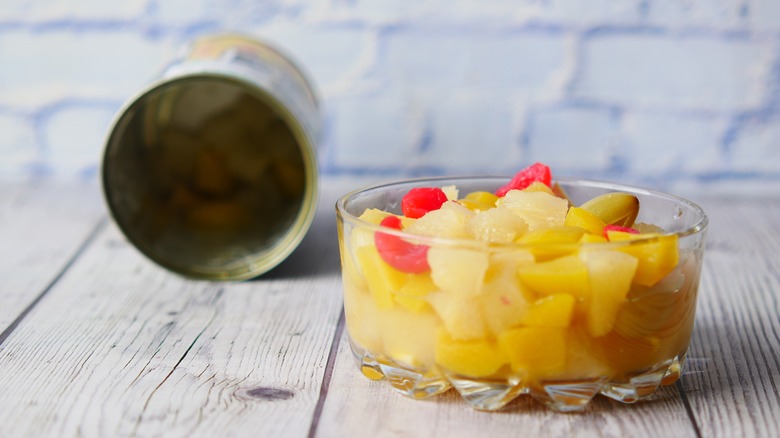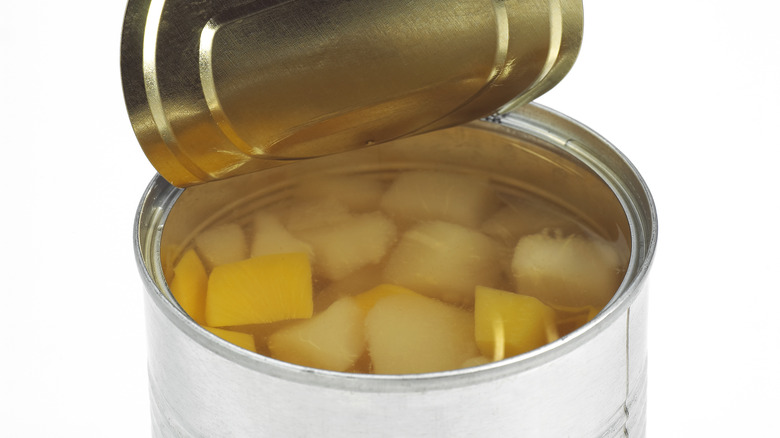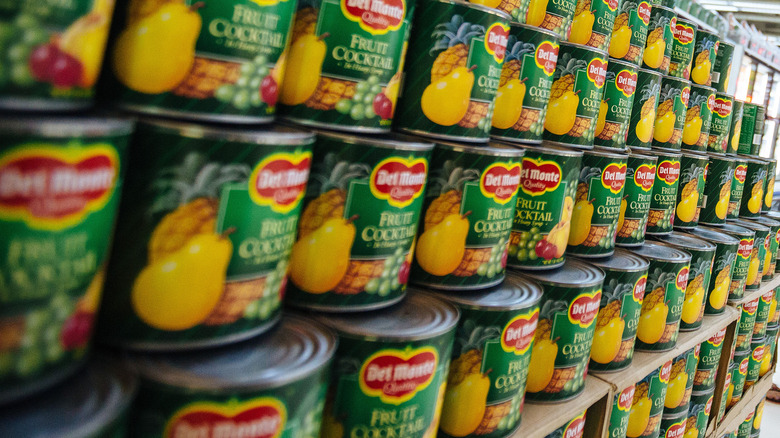The Unexpected Boozy Beginnings Of Canned Fruit Cocktail
Canned fruit cocktail is simply a sweet, preserved take on fruit salad, so what's with the name? You might assume it comes from the fact that fruit cocktail is often served in a cocktail glass, but its roots go deeper than that. It evolved through the long and peculiar history of fruit salad itself, which, at one point in time, often incorporated actual alcohol. The fruit cocktail truly earned its name, existing somewhere between fruit salad, dessert, and an aperitif.
The canned product we know today is a relatively recent invention, a product of the 1930s. It was never customary to add alcohol to these store-bought versions, and yet, they adopted the historical moniker given decades earlier to the boozy fruit salads that ruled American tables at the turn of the last century. We've come quite a long way since then, and the strangest thing is fruit cocktail is now legally forbidden to contain any alcohol at all. The story of this evolution goes beyond the stuff in the can, reflecting the chaotic history of American culture itself.
Fruit cocktail had a controversial reputation
It's hard to pinpoint the exact origins of fruit salad, as it depends on how you define it. Ancient societies consumed mixtures of fresh and dried fruits. The standard American fruit salad, however, was established in the mid-1800s, defined by the fruit being typically fresh, tropical, and geared toward the sweet tooth. As people experimented, they came up with some takes that seem rather far removed from what we consider salad, perhaps the most famous being Ambrosia, which incorporates marshmallows. These intriguing inventions were popular but also controversial.
In 1902, Sarah Tyson Rorer commented in her book, "Mrs. Rorer's New Cook Book," that "many Americans make a mixture of fruit, sugar, and alcohol, and serve them as 'salad.' These are not salads; are heavy, rather unwholesome, and will never take the place of a salad. I much prefer to call them fruit cocktails." Here we find two key revelations: the use of the term fruit cocktail and its direct relation to a dish made with actual booze.
Prohibition curtailed the addition of alcohol to fruit salad, and even once the ban on alcohol was lifted, they typically remained a booze-free food. This would carry over to the first canned fruit cocktail, invented by Herbert Gray of San Jose, California, and debuted in 1938 under the Del Monte brand. This established a new definition of fruit cocktail in American minds, a definition that eventually became the law.
The U.S. government has a strict definition of fruit cocktail
The United States Department of Agriculture has standards in place that determine whether a product qualifies as fruit cocktail. According to regulations, fruit cocktails must include the following: peaches, pears, seedless grapes, pineapple, and sweet or artificially-red cherries. Peaches are to account for no less than 30% of the weight of the fruit and no more than 50%. Pears must fall between 25% and 45%. Both grapes and pineapple cannot account for less than 6% of the weight, but while grapes can top out at 20%, pineapple is limited to 16%. Lastly, cherries must be kept between 2% and 6% of the total weight. As for the liquid in canned fruit cocktail, the drained fruit must be no less than 65% of the can's water capacity.
The impact of the USDA's regulations can be seen with a cursory glance at labeling. You may notice that while there are many canned fruit cocktails on the market, they don't all go by that name. Some call themselves fruit salad, fruit mis, or mixed fruit, and this isn't by choice. If they don't meet USDA standards, they are not allowed to use the term "fruit cocktail," which means any canned fruit mixture that goes by a different name deviates from the regulations in some way. In some cases, this can be a good thing. The government can do a lot but can't dictate your tastes.


